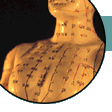Summer-heat
Summer-heat is the main pathogenic factor occurring only in the
summer. It is a yang pathogenic factor. Its characteristics are
described as follows:
Summer-heat is a yang pathogenic factor characterized by sweltering heat
If pathogenic summer-heat attacks the body, the clinical manifestations are yang-heat, syndromes, such as high fever, burning heat sensation of the skin, irritability, forceful and rapid pulse, etc.
Summer-heat consumes qi and yin (body fluid), and is characterized by upward direction and dispersion
Invasion of pathogenic summer-heat to the head region causes dizziness, vertigo, and excessive sweating due to the abnormal opening of the pores. Excessive sweating exhausts the qi and body fluid and manifests as thirst with desire to drink, dryness of the lips and tongue, constipation, yellowish and concentrated urine, etc.
Pathogenic summer-heat often combines with damp to cause diseases when the temperature and air humidity are very high
If summer humid-heat attacks the body, the manifestations are fever, heavy sensation of the head or even the whole body, stuffiness and fullness of the chest and epigastric regions, nausea, vomiting, abdominal distension, diarrhea, etc.
Pathogenic factors in summer are summer-heat, sun-stroke and summer humid-heat.
Main clinical manifestations of summer-heat: fever, excessive sweating, irritability, thirst with preference for cold drinks, shortness of breath, lassitude, general weakness, scanty and yellowish urine, rapid and xu (weak) pulse.
Main clinical manifestations of sun stroke: dizziness and vomiting for mild cases; sudden collapse, unconsciousness, profuse and cold sweating, cold extremities, forceful and xu pulse for severe cases.
This group of symptoms are caused by strong sun heat that internally affects the body qi activity leading to sudden prostration of qi and body fluid.
Main clinical manifestations of summer humid-heat: fever, irritability, stuffy chest, nausea, vomiting, anorexia, lassitude, loose stools, yellowish urine, soft pulse, yellow and sticky tongue coating, etc.
The symptoms resulting from summer humid-heat invasion include the common symptoms of summer-heat, such as fever, irritability, yellowish urine, etc., and the symptoms caused by the obstruction of dampened qi circulation, such as stuffy chest, nausea, vomiting and anorexia. Furthermore, there are also the symptoms of internal dampness, such as loose stools, soft pulse, sticky tongue coating, etc.
More about the other Exogenous Factors:
Wind,
Cold,
Damp,
Dryness,
Fire Heat and Mild Heat.
|

 This website is published, edited and designed by Raymond Cheng,
and reflects only and only his personal views and opinions in his individual capacity.
The information available at this website is not intended
directly or by implication to either diagnose or treat any
medical, emotional, or psychological condition or disorder.
It is also not intended to create a physician-patient relationship
between you and I or between you and Wyith Institute™ and The Office of Dr Raymond K K Cheng.
The information here is not a substitute for advice and treatment provided
by your physician or by another healthcare professional.
It is always recommended that consultation with local healthcare providers
be obtained for any of your specific health or medical concerns.
Furthermore, any products that can be purchased (yet you can see I don't have much
to sell here) through advertisers' banners or through links to other websites
are not either explicitly or implicitly given any warranty or endorsement
by me, my colleagues, Wyith Institute™ or any of its associated businesses.
This website is published, edited and designed by Raymond Cheng,
and reflects only and only his personal views and opinions in his individual capacity.
The information available at this website is not intended
directly or by implication to either diagnose or treat any
medical, emotional, or psychological condition or disorder.
It is also not intended to create a physician-patient relationship
between you and I or between you and Wyith Institute™ and The Office of Dr Raymond K K Cheng.
The information here is not a substitute for advice and treatment provided
by your physician or by another healthcare professional.
It is always recommended that consultation with local healthcare providers
be obtained for any of your specific health or medical concerns.
Furthermore, any products that can be purchased (yet you can see I don't have much
to sell here) through advertisers' banners or through links to other websites
are not either explicitly or implicitly given any warranty or endorsement
by me, my colleagues, Wyith Institute™ or any of its associated businesses.



 Thank you for visiting this TCM and acupuncture information website.
If you have previously been to this website, you might have
noticed that some of the pages on ancient historical ideas and
holistic thinkings related to Chinese metaphysics are temporarily taken offline.
This is because I will be revamping the whole website and be moving
those information into a new \"Ancient Chinese Culture\" section
so as to reflect a more current perspective on the interpretation
of some of the fundamental concepts as well as to include
some of the latest information in the area.
But if you have just found this website for the very first time, I welcome you again and
wish you could find what you require and, hopefully, you could also be benefitted
from reading the articles I published on this website.
Thank you for visiting this TCM and acupuncture information website.
If you have previously been to this website, you might have
noticed that some of the pages on ancient historical ideas and
holistic thinkings related to Chinese metaphysics are temporarily taken offline.
This is because I will be revamping the whole website and be moving
those information into a new \"Ancient Chinese Culture\" section
so as to reflect a more current perspective on the interpretation
of some of the fundamental concepts as well as to include
some of the latest information in the area.
But if you have just found this website for the very first time, I welcome you again and
wish you could find what you require and, hopefully, you could also be benefitted
from reading the articles I published on this website.